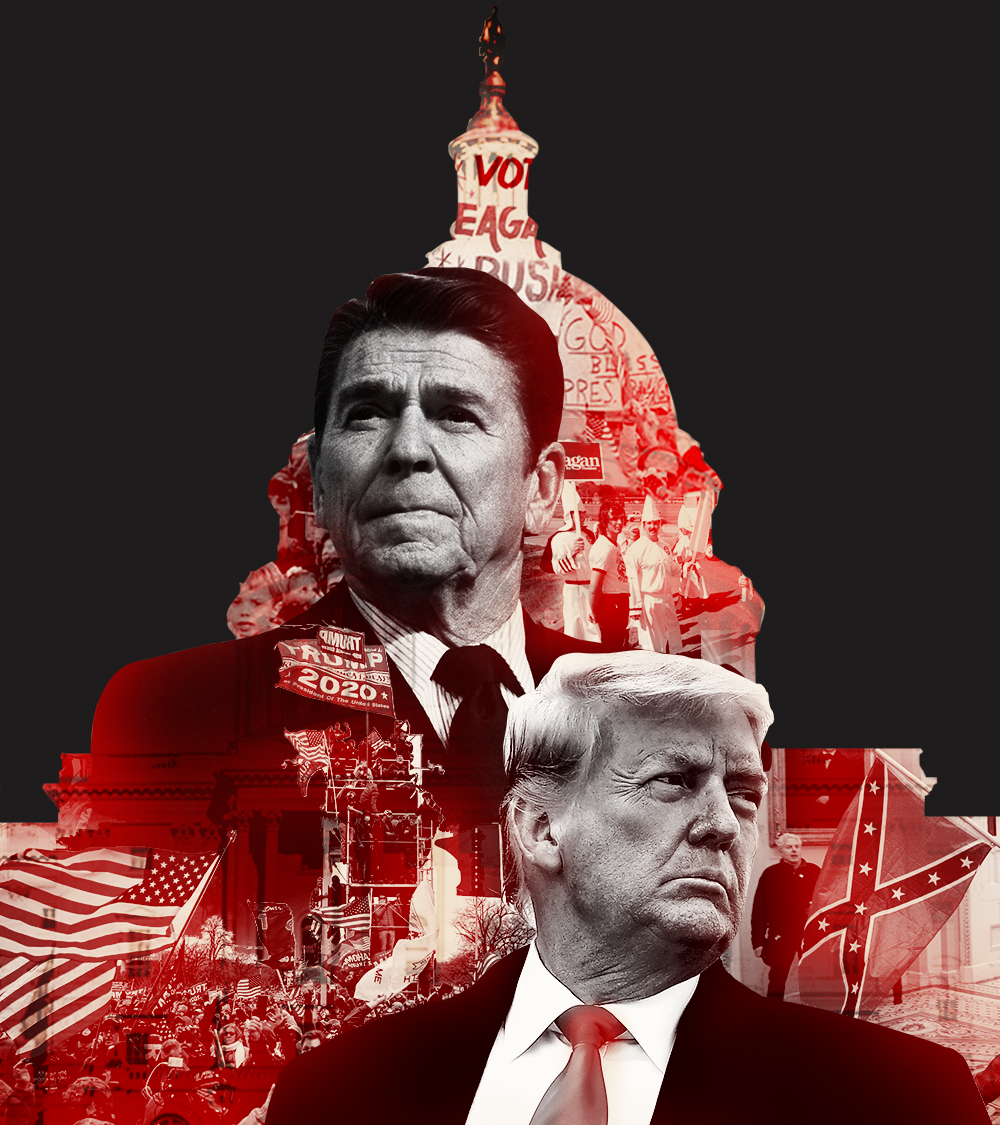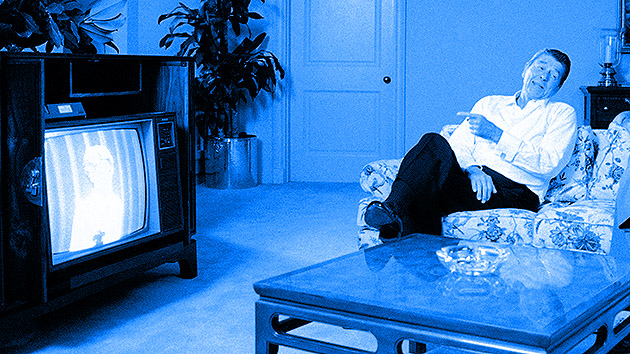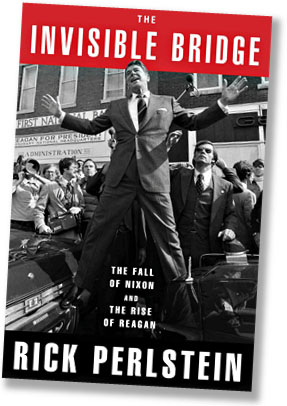On August 3, 1980, around 10,000 people packed into the Neshoba County, Mississippi, fairgrounds. The site is where what’s known as “Mississippi’s Giant House Party” takes place, the state fair that was established there in 1889 and has continued ever since. But this particular event was a huge draw for a different reason, as the master of ceremonies noted. “This is the first time we’ve ever had a nominee for the president of the United States,” he said rhapsodically. The crowd exploded into cheers. “We want Reagan,” they chanted as they waved Confederate flags. Soon rhythmic clapping accompanied their clamor for Ronald Reagan, the Republican presidential candidate and former California governor, who was about to speak.
His performance was quintessential Reagan, a combination of aw-shucks humor and anti-Soviet Cold War fear mongering, wrapped up in a staunch conservatism that would seduce a wide swath of voters for the next eight years. First, he warmed the crowd up with a few jokes—“I know people are saying Jimmy Carter is doing his best—and that’s our problem!”—and then pirouetted into “one of the great tragedies of welfare today.” It was his cue to invoke his favorite bogey—government bureaucracy. The only reason welfare spending had gotten so out of control is because a nameless blob of government workers, a sort of deep state, wanted it that way. “That bureaucrat needs them as clientele to preserve the job of the bureaucrats themselves.” More chants. More claps. More cheers.
But the event is notorious today largely for what he said next.
“I believe in states’ rights,” he offered matter-of-factly, as if he were expressing the most obvious sentiment imaginable. “And I believe that we’ve distorted the balance of our government today by giving powers that were never intended in the Constitution to that federal establishment.” Over the last 20 years, something had happened in their country. Something had been taken from this crowd, with all the talk of civil rights and a Great Society. “And if I do get the job I’m looking for,” Reagan continued a bit flirtatiously, “I’m going to devote myself to trying to reorder those.”
These days, the speech is more discussed than watched or heard. I’d never seen any footage until I put on The Reagans, a recent Showtime documentary series. In the usual telling, Reagan’s event was a study in dog-whistle politics. Neshoba County was where Black activist James Chaney along with Michael Schwerner and Andrew Goodman, white civil rights workers, had registered Black people to vote in the early ’60s as part of their work with the Congress of Racial Equality (CORE). In June 1964, they were brutally murdered by white vigilantes, at the behest of the Ku Klux Klan, their bodies dumped just a few miles from the county fairgrounds. Sixteen years later, Reagan came to this haunted place in a bid to win over what one Mississippi GOP big shot had called “George Wallace inclined voters.” Adopting the neo-Confederate code of “states’ rights,” he made a quiet appeal to the segregationists of Neshoba County and to the cause of the killers of Chaney, Schwerner, and Goodman.
The footage tells a slightly different story, however. Reagan, who days earlier had picked up an unwanted endorsement from the Ku Klux Klan, was certainly pitching himself as the candidate of the old racial order. But the idea that there was anything subtle about it seems ludicrous once you’ve seen the video. No one in that crowd needed to know the code words to understand what he was doing; no one needed to be attuned to some secret frequency. “What we’ll have to do is to bring back to this country what is so evident here,” he implored to those sitting on bleachers and standing on the red clay track. “Bring back the recognition that the people of this country can solve the problems, that we don’t have anything to be afraid of as long as we have the people of America.”
In front of a mass of white people, with Confederate flags waving nearby, Ronald Reagan was saying the government had taken what was theirs, and that he was running for president to reclaim it. He had gone to Dixie to say stop the steal.
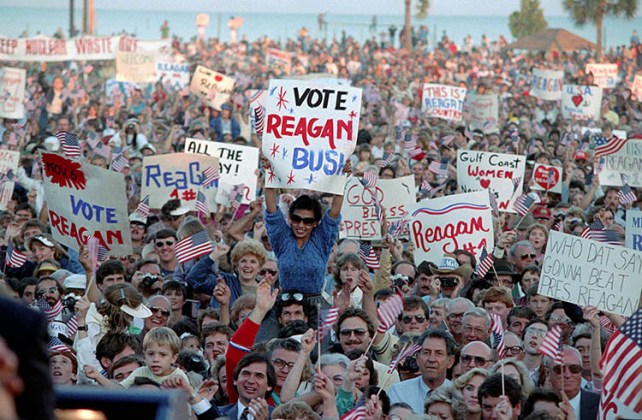
A trip to Gulfport Mississippi at a Reagan Bush 1984 Rally.
Courtesy Ronald Reagan Library
Fast forward to 2021, to another rally against the federal government and another mass of white people. “Our country has had enough,” President Donald Trump said on January 6 in front of a crowd of self-styled patriots who professed outrage at a “stolen election” and who once again were convinced something had been taken from them. “We will not take it anymore, and that’s what this is all about.” Soon enough, people were marching down to the Capitol—the fulfillment of Reagan’s vision of “the people” taking it upon themselves to solve the country’s “problems.”
History is rhyming all around us these days. Showtime’s miniseries documents the life of Ronald Reagan first as movie star, then as politician, and ultimately as president of the United States, but under its breath it is also a story about Donald Trump and the present. For me, born to immigrants at the very end of his presidency, the deconstruction of the canonized Reagan feels more like a revelation. I turned on the documentary solely for entertainment purposes, but it wasn’t long into the first episode when I had my first holy shit moment. Every catastrophe of our current moment—economic inequality, government sabotage, the reinforcement of the racial hierarchy, and on and on—has its echo if not its origin in Reagan’s presidency. It’s easy enough to lament that history repeats itself, and we never learn a single thing. The documentary is evidence that, in fact, some people have learned much too much.
Reagan’s first campaign slogan? “Let’s Make America Great Again.”
White grievance as ideology became palatable in Republican Party politics when Goldwater first campaigned on an anti–civil rights platform in 1964, and then valorized when Reagan made states’ rights part of his messaging in 1980. Since then, right-wing politicians have continued to tell white people that their country has been taken from them—even when Republican presidents who campaigned on taking it back occupy the White House.
Before Trump, Republicans took care never to clearly explain who did the taking, counting on their audience to make the make the connections for itself. Reagan faulted “welfare queens” and “big government.” George W. Bush indicted “terrorists” in foreign lands, and Mitt Romney famously blamed “47 percent” of the people. But when Trump, who never cared about the respectable veneer—no surprise from a wealthy white man who’s never faced real consequences—brandished the mantle of white grievance, he was very specific in whom he blamed for the so-called predicament of white America.
Something has been taken from you, Trump insisted, even before he lost the election. And there they are! Immigrants, Black people, Jewish philanthropists, Republicans who didn’t show the appropriate amount of loyalty, and, when all else fails, socialists. They were all to blame. It was incitement from the very start.
Trump was so successful in recreating what made Reagan so popular among whites, explicitly pandering to their sense of racial grievance, that as I watched the documentary I found myself almost shaking with frustration. Reagan vandalized the tax code, redistributing wealth up the ladder. He ignored a deadly plague for political purposes, with damning, catastrophic repercussions. My frustration transformed into sheer rage as the parade of smug, prosperous, ancient Reagan-era notables appeared on screen. Political strategist Stuart Spencer (who ran Reagan’s first gubernatorial campaign in California) and former White House Chief of Staff and Treasury Secretary James Baker, both very much looking like the nonagenarians they are, practically dripped with glee while recounting Reagan’s legacy. Even after everything they’d destroyed, here they were in polite society fondly reminiscing about the good old days.
The Reagan documentary is a helpful guidebook for those who still may be baffled by how a TV star with no political experience became president of the United States. Reagan “didn’t have what I would call a coherent political philosophy,” said his biographer Lou Cannon. “But he wanted to come out on top.”
When Reagan made the pivot to politics, his Hollywood career was foundering; his first wife, Academy Award–winning actress Jane Wyman, had filed for divorce; he wasn’t making that much money and was struggling to find a path to become the American hero he just knew he was destined to be. He had abandoned his New Deal Democratic roots—in the midst of the Depression, the lives of both his salesman father and brother were improved by Roosevelt’s massive government programs—when he met his future wife Nancy. According to the documentary, the conservative ideals of Nancy’s stepfather made a big impression on the handsome B-list actor. He served six terms as the president of the Screen Actors Guild, less a union man than a narc—he acted as an FBI informant during the McCarthy period. Since his career as an actor never really took off, he signed a contract with General Electric in 1954 to promote their products and established some success as their corporate spokesman. But his true destiny emerged after he delivered a stemwinder speech entitled “A Time for Choosing” for Barry Goldwater at the convention in 1964. He was 53 years old and immediately became a politician to watch, running for governor of California in 1965 and then winning the following year.
During the Reagan era, the political media machine rallied around the idea of a TV celebrity president. CBS’s Lesley Stahl describes herself as “melting into a puddle” the first time she saw Reagan in person—despite acknowledging that he looked older and frailer than he did on TV. Stahl also claims that her bosses removed criticism of Reagan in her stories because the public liked him so much. Let me offer a counterpoint: The public liked Reagan so much only because so many in the media splashed around with Stahl in that puddle of adoration.
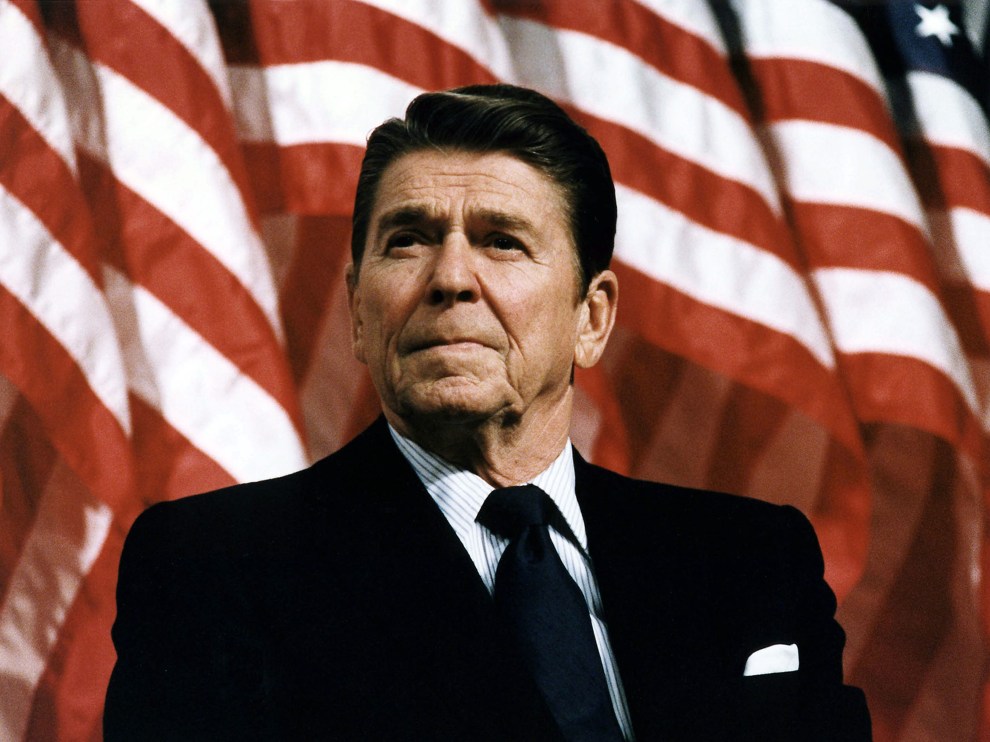
Ronald Wilson Reagan, 40th President of the United States (1981-1989)
PHOTO12/ZUMA

US President Donald Trump boards Air Force One before departing Harlingen, Texas, on January 12, 2021.
Mandel Ngan/AFP/Getty
Trump followed an abbreviated version of that same trail blazed by Reagan—lacking only the experience of running for a lower office and actually governing. When the 45th president was struggling to make money off of his reality TV show and corporate endorsements, he turned to politics. Of course, by the time Trump became a political figure in his own right, celebrity culture had changed considerably. Trump’s celebrity was of the New York City tabloid variety: a twice-divorced womanizer with multiple and credible sexual assault allegations against him, whose stardom was based on a TV show in which the savvy businessman fires people who don’t know how to play the game.
By the time I tuned into the third installment—which covered Reagan’s presidential years—both the documentary and I were beginning to sound like a broken record. “Sound familiar?!” I’d bellow intermittently to my spouse. Reagan stacked the federal agencies with officials who didn’t even believe in the agency’s mission; so did Trump. Reagan and the First Lady relied on Joan Quigley, an astrologist, to determine when they should hold press conferences and how the president should handle diplomatic talks with the Soviet Union. Mike Lindell, a self-described former crack addict and pillow salesman, was one of President Trump’s favorite surrogates. One of Reagan’s first major act as president was a gigantic tax cut favoring the wealthy. Yup, so was Trump’s. And the unholy alliance between right-wing politicians and evangelicals that was initiated by Reagan was consummated by Trump.
It’s impossible to decouple Reagan’s economic policies from his racial politics. “Government is not the solution to our problems,” Reagan explained at his first inauguration in 1981. “Government is the problem.” With this, the floodgates opened. Reagan slashed social programs until there was almost nothing left, indulging in the ludicrous fantasy that the tax benefits enjoyed by the rich would trickle down to the rest of us. The GOP took this conceit and continued to enact policies designed to make the lives of those in need even worse. A few decades later, Trump would return to the very same scene to impugn government again. “For too long, a small group in our nation’s capital has reaped the rewards of government, while the people have borne the cost,” he said at his first and only inaugural address in 2017. “The establishment protected itself, but not the citizens of our country.”
As the explicit language of the early 20th century became more taboo, racist whites were forced to come up with new ways of calling Black people racial slurs without actually saying the words. Reagan was an expert at dog-whistle politics. White people fighting integrated neighborhoods were simply looking out for their own property values. Policing was described as “the thin blue line that holds back a jungle which threatens to reclaim this clearing we call civilization.” And the rich were doing their very best to create jobs, but so-called welfare queens and strapping young bucks were quite content to watch expensive color televisions, drive nice cars, and eat steak courtesy of the government while hard-working families (read: white ones) struggled to make ends meet. Turns out, it’s easy to make government social programs the problem when you insist that all it does is supply greedy, lazy Blacks with an endless supply of money, which most decent people earn through hard work.
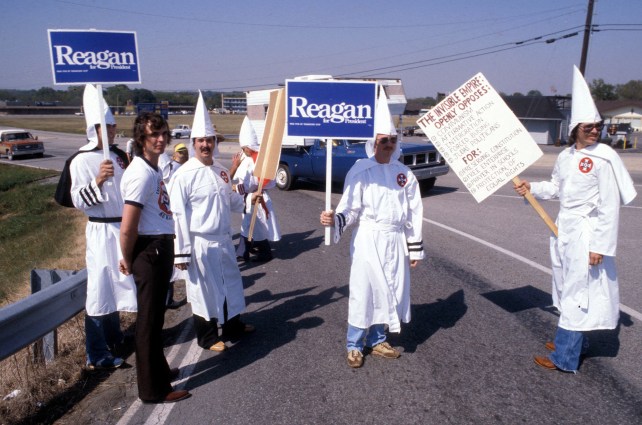
Men dressed up in KKK costumes shows signs of support for presidential candidate Ronald Reagan during the 1980 campaign.
Arthur Grace/ZUMA
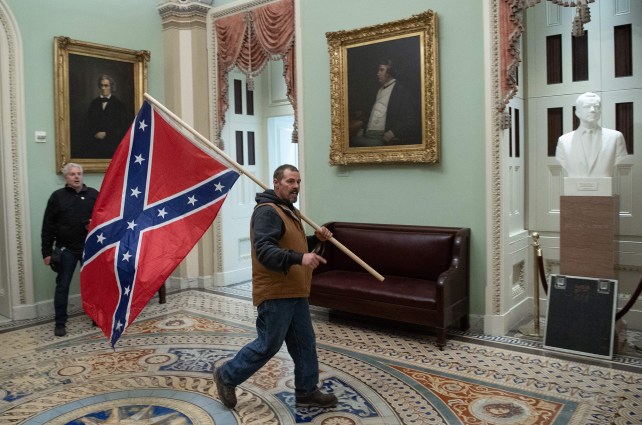
A Trump supporter carries a Confederate flag as demonstrators breeched security and entered the Capitol, while Congress began the certification of the 2020 presidential election.
Saul Loeb/AFP/Getty
This idea became so ingrained in American politics that when President Bill Clinton won the election in 1992, he was careful not to sound like some now thoroughly discredited New Dealer appealing to poor people. Clinton was a “New” (aka Reaganesque) Democrat. He signed a sweeping welfare reform bill in 1996 that essentially picked up where Reagan had left off. Clinton didn’t become president by shying away from Reaganism, but by embracing it and making it his own.
If Reagan consolidated the new elements of social reaction with a neoliberal economic program, and Clinton adapted to the paradigm, Trump did Reaganism on steroids. In public, Reagan was careful to use language that he could theoretically defend as race-neutral (i.e. “jungle paths” and “welfare queens”); Trump dispensed with the niceties and used his bullhorn to call immigrants rapists and criminals, to refer to Black countries as shitholes, and to tell women of color in Congress to “go back” to where they come from. Of course, Reagan doesn’t deserve credit for trafficking in a more polite racism. Behind closed doors, he once denigrated African delegates to the United Nations with Richard Nixon. “[T]hose monkeys from those African countries—damn them—they’re still uncomfortable wearing shoes!” Reagan said. Nixon responded with a belly laugh. The Access Hollywood tapes, in which Trump bragged about his sexually predatory behavior, was only a glimpse of his contempt for women. One can only imagine the other unrecorded conversations about people of color.
Throughout the documentary, the real people whose lives Reagan’s policies made immeasurably more difficult are only distant characters. But there is a painful scene. It takes place after Reagan, who once bragged about being the first union president to run for president of the United States, fires the striking air traffic controllers. “I can’t believe the government would do something like this to us,” an anonymous man says earnestly in an unidentified news spot. The camera pans over his face as it twists in genuine confusion. What a gut punch. For those of us who came of age in the immediate aftermath of the September 11 terrorist attacks and entered the workforce during the Great Recession, getting screwed over by the government does not feel like such a fundamental betrayal; after Reaganism, we grew up with low expectations.
Convincing the public that the government serves little purpose and attempting to strip it of its core functions has dire consequences. When the coronavirus reached the United States, and Trump first tried to ignore it and then downplay it, even those of us who did not exactly have high opinions of the president were shocked by his brazen incompetence and apparent indifference in the face of a massive life and death situation. How could a country that purports to be as technologically sophisticated and caring as the US have such a horrifyingly inept response to a global pandemic? But those who recall the AIDS crisis and Ronald Reagan’s response were probably less surprised by how the cavalier leadership of a celebrity right-wing president could cause countless unnecessary deaths.
In 1981, a reporter asked White House Press Secretary Larry Speakes about a mysterious disease that had just begun circulating. “They’re calling it the gay plague,” the reporter said referring to the fact that it seemed to be heavily concentrated within the gay community. “I don’t have it, do you?” Speakes responded with a dismissive chuckle. It would be years until the Reagan administration acknowledged the AIDS crisis that had engulfed the country. While people marched in the streets demanding funding for AIDS research and an acknowledgement of what was happening in marginalized communities, the Reagan administration just averted its gaze. It was only after actor Rock Hudson died from the virus, and movie star Elizabeth Taylor lobbied the president that Reagan made his first speech about AIDS. But even then, he couldn’t help himself. “I’ve also asked [the Department of Health and Human Services] to add the AIDS virus to the list of contagious diseases for which immigrants and aliens seeking permanent residence in the United States can be denied entry,” he said during the pivotal speech. Some in the crowd booed at the suggestions.
Enter Dr. Anthony Fauci. The well-respected head of the National Institute for Allergies and Infectious Diseases has his own complex history in responding to the AIDS pandemic. Prominent AIDS activist Larry Kramer first berated Fauci for the federal government’s failure to act in the 1980s. But Fauci was educable and willing to change course when he realized how wrong he had been. The two remained close friends until Kramer passed away in 2020.
We see the young Fauci in the documentary saying it’s “outlandish” to suggest that the AIDS crisis was affecting only a small group of “unsavory” people. “We were seeing an emerging catastrophe,” he recalls in the documentary. “And he wanted nothing to do with it.”
Courtesy of Showtime.
Nearly 40 years later, Trump-era Fauci is still frustrated. If you close your eyes, he could have been talking about a different president, Reagan’s rightful heir to the throne.
The documentary is not in chronological order, so while the AIDS pandemic began in the early years of the Reagan administration, the consequences of ignoring the virus aren’t explored until the last episode. While it was easy to draw parallels as I watched Reagan’s presidency unfold, it was the ending—a deadly plague killing marginalized people while the government all but shrugged its shoulders—that felt the most painfully and maddeningly familiar.
In 1986, Ronald Reagan said to raucous guffaws from the crowd that the most terrifying nine words in the English language are, “I’m from the government and I’m here to help.” This cheap laugh line became a familiar point of reference in the American psyche, especially for the Republican Party. Thirty-five years later when the coronavirus swept the world, the Trump administration scoffed at the idea of mobilizing government to defeat it, and his congressional leadership only supported his indifference.
By the end of 1988, when Reagan was on his way out of the White House, the CDC had recorded more than 46,000 dead from AIDS. At the end of Trump’s first and only term, approximately 390,000 people have died from the coronavirus. The horrific death tolls are the end result of an ideology that chooses tax cuts for the wealthy over social programs, the dismantling of government over strong public institutions, and individualism over collectivism.
With just a few minutes before the final credits, AIDS activist Sean Strub explains what Reagan’s biggest mistake was in handling the epidemic. But his characterization also amounts to a philosophy of government by ungovernment. As Strub puts it, “He abdicated responsibility.”
The siege at the Capitol was the culmination, specifically, of six decades of telling white people that something had been unjustly taken from them, though in a larger sense the looming specter of equal justice for all has plagued American politics since the failed Reconstruction era. After the Confederacy lost the Civil War and a multiracial coalition attempted to rebuild the South based on the premise of extending civil rights to recently freed slaves, whites sabotaged the experiment with violent campaigns and a broader policy known as Redemption. Our politics ever since have been defined by that essential dialectic between Reconstruction and Redemption.
We all know what happened on January 6 when Congress was working to certify the vote for Joe Biden. We know that under normal circumstances a joint session of the members of Congress along with the vice president would engage in a pro forma count of the electoral votes from each state and cement the winner’s victory. And we know, that while this was just beginning, outside the White House, during an hourlong speech littered with grievances against his political enemies and his own vice president, Trump urged his supporters to head down to the Capitol. “You’ll never take back our country with weakness,” he said. “You have to show strength.” Their unflinching allegiance to Trump led to a full-blown insurrection in Washington, DC.
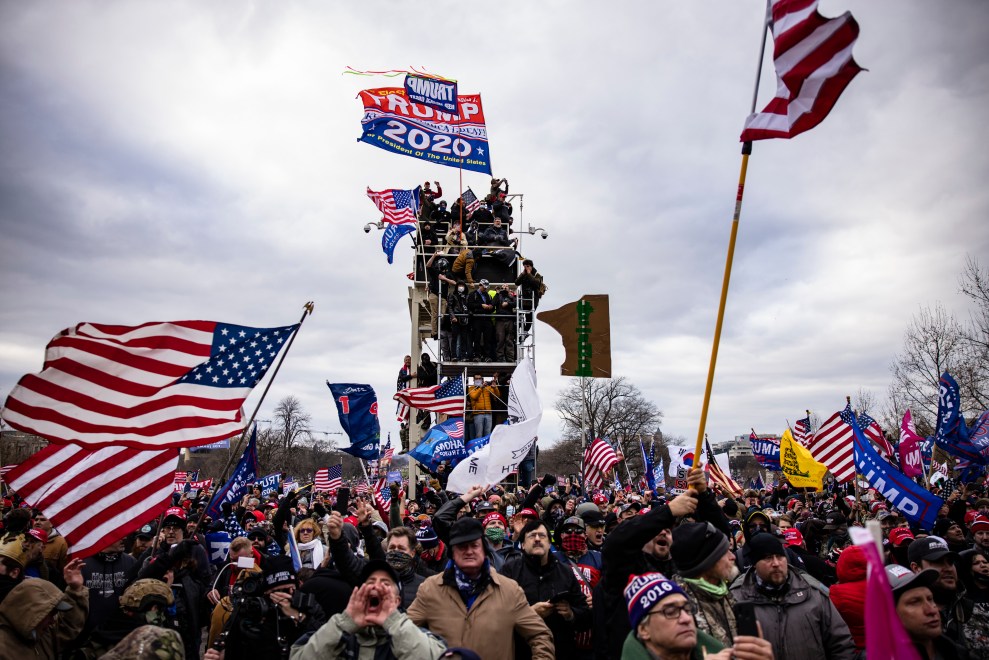
Pro-Trump supporters storm the U.S. Capitol following a rally with President Donald Trump on January 6, 2021 in Washington, DC. Trump supporters gathered in the nation’s capital today to protest the ratification of President-elect Joe Biden’s Electoral College victory over President Trump in the 2020 election.
Samuel Corum/Getty
After the wreckage in which hundreds of aggrieved Trump supporters stormed the Capitol building, destroying windows, statues, and notably, a display honoring the late civil rights activist turned Congressman John Lewis, while chanting death threats about Vice President Mike Pence, the so-called moderate Republicans sought to distance themselves from the death and destruction and remind the American people, We’re better than that! Naturally, the best way to do that was to invoke none other than the Gipper. “I once said the party of Lincoln and Reagan is off taking a nap,” John Boehner, the former Speaker of the House, tweeted the day after the rampage. “The nap has become a nightmare for our nation. The GOP must awaken.” Boehner, for his part, presided over a party that let the rot of birtherism fester until one of its leading proponents became the president of the United States. Was the GOP asleep then too? Also on the day after the insurrection, Frank Lavin, a White House aide under Reagan, offered the readers of the conservative National Review a suggestion for a homeopathic remedy for the ills of the GOP: “The Cure for Trumpism? Reaganism.”
Perhaps these loyal Republicans might want to watch a documentary and replace the images of Ronald Reagan with those of Donald Trump. From the destruction of public institutions to the appeals to white grievance, Trump embodied all the core values of Reaganism. He spent four years disregarding the rule of law and basic respect for human life. He spent his entire presidency demanding loyalty, regardless of circumstance, and Republicans were content to hand it over. It is oddly fitting that a violent racist who can’t be trusted to have a Twitter account became the standard bearer for the party of that genial cowboy who survived an assassination attempt. Perhaps the best thing that Donald Trump did as president was to expose Reaganism for the scam that it always had been.
The documentary is deliberate in offering up the Reagan era as a precursor to ours. But you can’t watch the scene at the Neshoba County fair today, in the aftermath of the sacking of the Capitol, without seeing some larger continuities in the American reactionary tradition. The elements are familiar by now: a rebel flag, a claim of dispossession, a threat of Black equality, a lost cause of one kind or another, a federal government “perverted from the purposes for which it was ordained” (that’s Jefferson Davis) that needs to be starved or else a “man is not free” (Reagan) and won back from “elites…who will say anything to keep a rigged system in place” (Trump). The defense of privilege in America has always looked and sounded the same.
